The growth in demand from renewable energy applications (e.g., wind and solar) is accelerating. Longer-term, demand will increase for valves related to decarbonization, and carbon capture and energy storage. We expect a growing pressure on production capacity as utilization increases on the back of stronger new orders coming from these emerging markets. Manufacturers who succeed in getting their low-emission technologies to market earliest will be more competitive, and therefore likely to win more contracts.
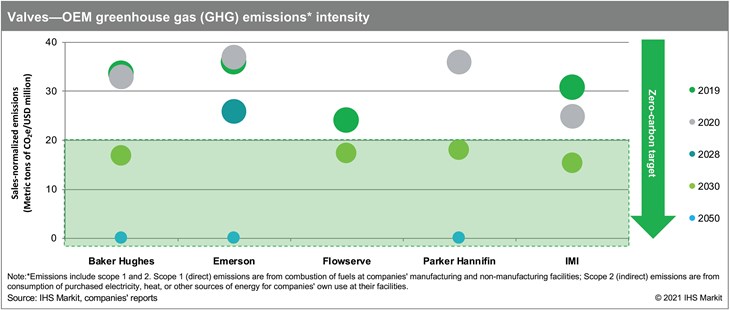
Suppliers Cut Their Own Emissions Footprint
Suppliers have been reducing their own emissions footprint. Some have set up long-term goals to increase energy efficiency and reduce carbon dioxide (CO2) emissions. Emerson, for example, plans to reduce greenhouse gas (GHG) emissions by 20%, normalized to sales, across its global manufacturing footprint and shared service facilities from 2018 to 2028, reaching net-zero emissions by 2050. It aims to improve its internal environmental sustainability performance by reducing its own GHG emissions, energy consumption, and water consumption. The company reported a 10% decrease in CO2 emissions, an 11% decrease in global electricity usage, and a 9% decrease in global water consumption in 2020.
Similarly, Flowserve proposes to reduce carbon emissions intensity by 40% by 2030, using 2015 as a baseline. Its emission-cutting…by 2030” to this: Its emissions-cutting target is to reduce combined direct (scope 1) and indirect (scope 2) carbon emissions of 29.4 metric tons of CO2e per million US dollars in revenue in 2015 to 17.4 metric tons of CO2e or lower by 2030. Flowserve aims to achieve this target through a combination of efficiency improvements, renewable energy project development, and other measures to offset GHG emissions.
Other key valve manufacturers such as Baker Hughes, IMI, and Parker Hannifin are also adopting strategies for GHG emission control. Some common approaches are:
• Implementing emissions reduction initiatives across manufacturing, supply chain, logistics, energy sourcing and generation.
• Downsizing current services and equipment portfolio with more emphasis on the energy transition and technology needed for renewables.
• Focusing on a broad range of motion and control technologies to support the use of various clean energy sources such as batteries, fuel cells, hydrogen, sustainable fuels, and renewable energy.
• Recycling more waste generated by manufacturing operations and continuing to reduce the volume of waste sent to landfills.

Market Penetration/Development
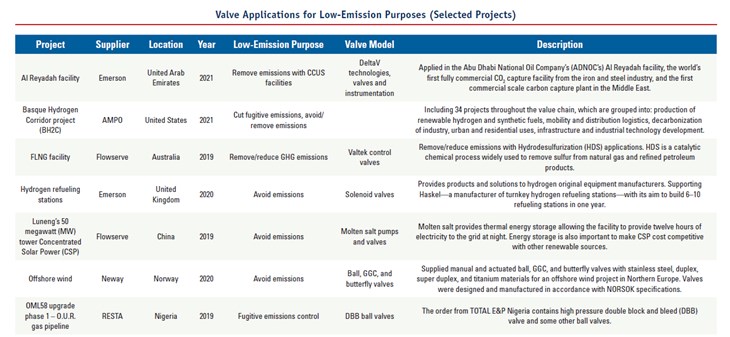
Emissions reduction refers to carbon dioxide (CO2) reduction—carbon capture, utilization, and storage (CCUS); carbon capture and sequestration (CCS); and GHG emissions reduction.
Clean/renewable energy refers to onshore/ offshore wind and solar power; nuclear, other energy resources such as biofuels/bioplastics.
Energy efficiency can be achieved through suppliers’ energy recovery devices and digitization and automation technologies.
Major suppliers have established track records in helping clients reduce their emissions footprints with four major applications:
• Reducing emissions with low/no-emission technologies that eliminate fugitive emissions from valves in critical processes.
• Removing emissions from the atmosphere with CCUS/CCS facilities where specially-designed valves are installed.
• Avoiding emissions with valves installed in facilities using renewable energy resources such as solar, wind, and other low/no-carbon energy resources such as biofuels, hydrogen, nuclear, geothermal, and coal-to-natural gas.
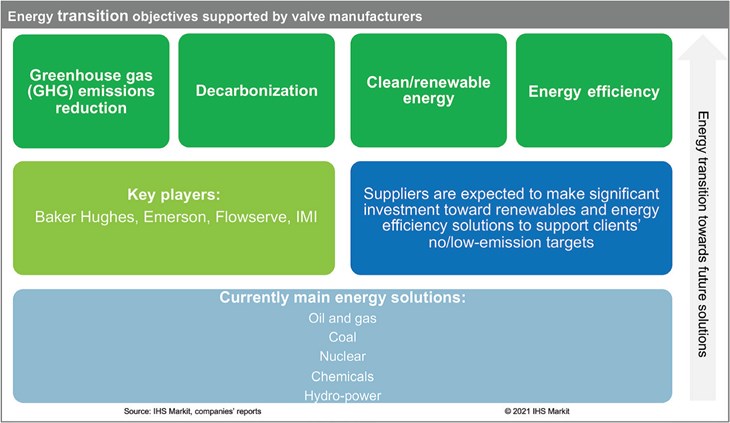
Product Development/Innovation
Today, more clients are moving to lower their carbon footprints, including by replacing valves with newer models that have lower greenhouse gas emissions.
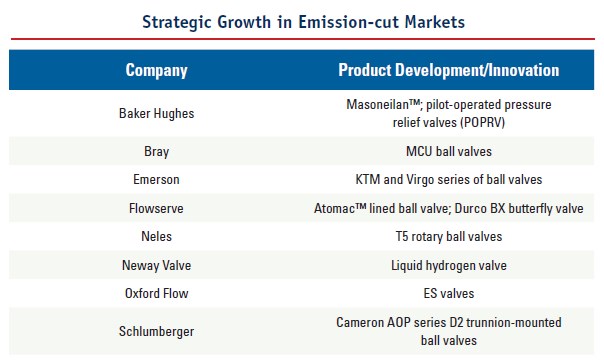
Bray’s ball and butterfly valves are applied in facilities including refineries, chemical and petrochemical plants, and terminal and storage for fugitive emissions control, and are moving to upstream sector. Its media-containmentunit (MCU) ball valves can be used for fugitive emissions control.
Emerson’s KTM and Virgo series of ball valves are for low-emission solutions, which have achieved fugitive emissions testing (FET) to ISO 15848-1 tightness class A/B with endurance class CO1/2/3 for a wide temperature range, in valve pressure class from 150 to 2,500.
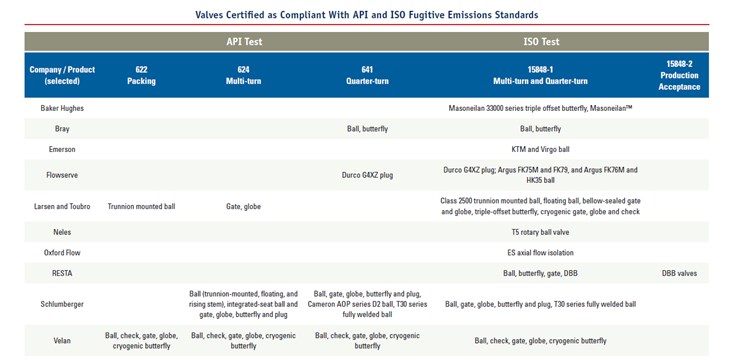
Schlumberger’s low-emission valves include trunnion-mounted ball, floating ball, and rising stem ball valves— along with integrated-seat ball, gate, globe, butterfly, and plug valves. In September 2021, it launched Cameron AOP series D2 trunnion-mounted ball valves that can be used in oilfield production applications.
Business opportunities are emerging for valves suppliers because more customers are committing to lower GHG emissions operations. Clients’ efforts to reduce their emission footprints have added a new layer to the complexity of the valves market, stimulating the development of low emission, zero-carbon products and technologies. Entry barriers are high for new market entrants because clients are more willing to work with suppliers with long track records and advanced technologies. Threats to the existing suppliers are limited. As front runners, major manufacturers are well-established suppliers and began offering low-emission products to clients even prior to the push for energy transition. Manufacturers who succeed in getting their low-emission technologies to market earliest will be more competitive, and therefore likely to win more contracts. We expect the potential market landscape to become increasingly consolidated, with major suppliers gaining more shares.


